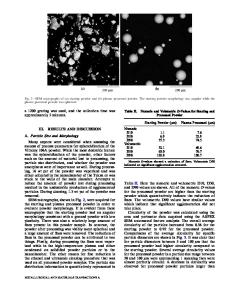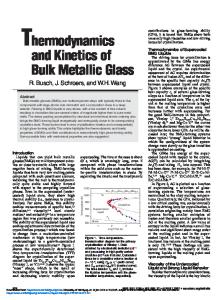Volume changes in Vitreloy bulk metallic glass during room temperature high-pressure torsion
- PDF / 614,603 Bytes
- 6 Pages / 612 x 792 pts (letter) Page_size
- 99 Downloads / 281 Views
rhard Schafler Physics of Nanostructured Materials, Faculty of Physics, University of Vienna, A-1090 Vienna, Austria
Ádám Révésza) Department of Materials Physics, Eötvös University, Budapest, H-1518, Budapest, Hungary (Received 21 April 2008; accepted 5 September 2008)
Commercial Zr44Ti11Cu10Ni10Be25 bulk metallic glass (Vitreloy 1b) disk was subjected to extreme plastic deformation by high-pressure torsion at room temperature. Two-dimensional mapping by high-intensity synchrotron x-ray diffraction in the plane of the shear deformation reveals no evidence of nanocrystallization; however, average effective volume changes as a function of the deformation can be evaluated.
I. INTRODUCTION
Bulk metallic glasses (BMGs) have received increased attention from scientific and technological view points in the past couple of decades. BMGs usually possess high strength, large elastic strain limit, and excellent wear resistance.1,2 The deformation of BMGs is commonly described in terms of the free volume model, which predicts a significant increase in atomic mobility and a strong dependence of strain rate on slight changes of the local free volume.3,4 Well below the glass transition temperature (Tg), inhomogeneous plastic deformation of BMGs at high stresses is concentrated in few thin shear bands. Experimental observations by transmission electron microscopy have shown that the distribution of free volume in the vicinity of shear bands can undergo drastic changes.5,6 Recently, a change in the excess free volume content on a macro-length scale has also been studied during in situ thermal cycles by synchrotron x-ray diffraction (XRD).7 In these tests, the excess free volume is obtained from the small relative increase (in the order of 10−3–10−4) in the average atomic distance, presuming an isotropic glass. Likewise, by measuring the small distortion of the two-dimensional (2D) diffraction spectrum, elastic strain has been quantified by in situ lowtemperature elastic loading.8,9 When reasonable plastic deformation is reached in uniaxial creep tests around Tg,
a)
Address all correspondence to this author. e-mail: [email protected] DOI: 10.1557/JMR.2008.0416 J. Mater. Res., Vol. 23, No. 12, Dec 2008
http://journals.cambridge.org
Downloaded: 07 Apr 2015
residual structural changes can also be observed in metallic glasses.10–12 At temperatures well below Tg, the relative volume fraction of the plastically deformed material is low due to the extreme localization of shear bands13; therefore, the small contribution of plastic deformation is difficult to detect by macroscopic methods. Recently, several studies have focused on dispersing the applied strain among a large number of competitive shear bands, either by introducing inhomogeneity in the microstructure14,15 or by surface constrains techniques,16–19 to enhance the ductility of BMGs. The high-pressure torsion (HPT) technique, originally used for producing porosity-free bulk ultrafine-grained specimen,20 can serve as an ideal surface constrain technique to achieve ex
Data Loading...











